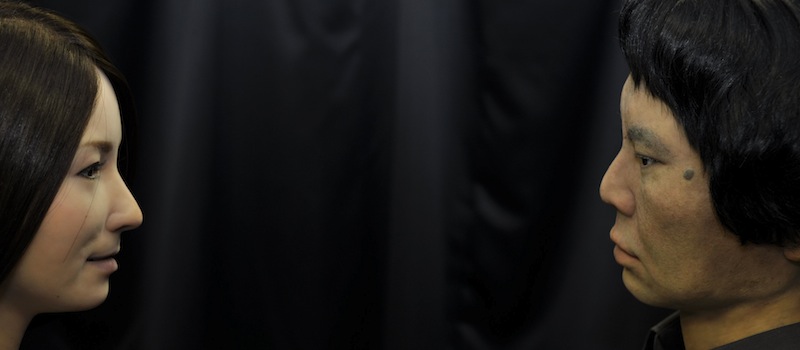What is Geminoid?
A Geminoid is an android whose appearance closely resembles a specific human “model”. Geminoids’ bodies are constructed by precisely measuring human models with a 3D scanner; gypsum is used to accurately capture facial contours. Currently at ATR, there are two Geminoids: Geminoid HI-2, a copy of Dr. Ishiguro, and Geminoid-F, a female android. HI-2 and F both use pneumatic actuators instead of electric motors; this is because pneumatic actuators can realize very human-like motions.
Geminoid HI-2 has 50 degrees of freedom (DOFs) and can perform not only facial expressions but also gestures using its entire body. Thus, Geminoid HI-2 can act in a natural and human-like manner. However, since it is not possible to fully fit 50 actuators inside the Geminoid’s body, a portion of the mechanism is stored in a control box outside the robot’s body. A large compressor is also necessary, making Geminoid HI-2 difficult to transport. Therefore, Geminoid-HI-2 is intended to be used as a fixed platform for experiments.
In contrast, we have restricted the number of DOFs in Geminoid F to 12, making her smaller and less expensive. Thus, we were able to fit everything inside her body except the compressor. However, even the compressor is smaller; therefore, it is easier to transport Geminoid F. As well, most of the 12 DOFs are located in her face, allowing Geminoid F to perform natural facial expressions during conversations with no loss to expressive power.
Development of Teleoperation system
The Geminoid teleoperation system consists mainly of an “android server” and a “teleoperation client”. The server and client communicate through the internet, making the teleoperation system easy to extend.
The client features a face recognition system and a mouth motion generation system. Information including facial expressions and the operator’s facial orientation is captured by a web camera, automatically translated into motion commands for the robot, and sent to the server. Mouth movements are generated in real-time by analyzing the operator’s speech data; this allows synchronization of the operator’s speech and the robot’s mouth motions.


